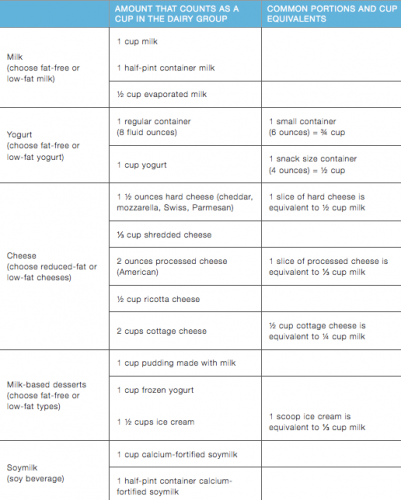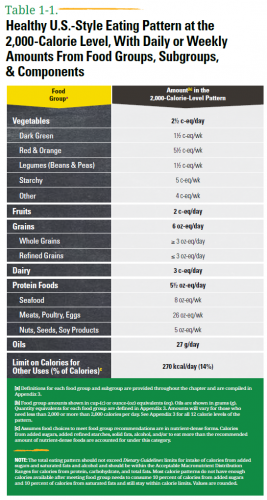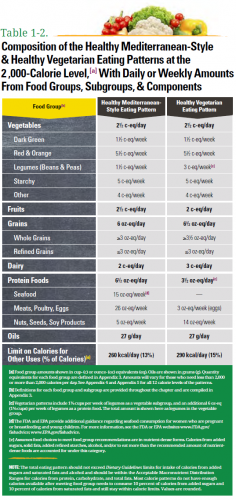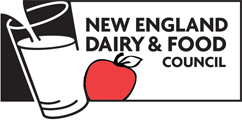Is it a coincidence that Valentine’s Day lands in the middle of the month and the heart in the middle of your chest? February is the month of love, and what better month to show some love to your heart!
In this blog post, you’ll learn about:
- Three nationally-recommended healthful eating patterns.
- Recommended portion sizes for dairy.
- How dairy fits into each eating pattern.
What do the Dietary Guidelines Recommend?
To better reflect how people eat, the 2015-2020 Dietary Guidelines for Americans (DGA) shifted its focus from nutrients to meal patterns. Three healthful patterns were listed:
- Healthy U.S.-Style Eating Pattern
- Healthy Mediterranean-Style Eating Pattern
- Healthy Vegetarian Pattern
Three eating patterns were described because people eat differently based on preferences and culture, among other reasons.
Science shows that healthful eating patterns are associated with a reduced risk of cardiovascular disease (CVD), with some evidence showing a reduced risk of type 2 diabetes, overweight, obesity, and certain types of cancers. For instance, colorectal and post-menopausal breast cancers.

Regardless of the eating pattern, each includes daily doses of low-fat and fat-free dairy products. Since an 8-ounce glass of milk provides nine key nutrients, dairy is a quick way to ensure you’re filling your body with the nutrients it needs.
How Much is a Serving of Dairy?
Per the guidelines, one “dairy equivalent” is as follows:
- Milk: 8-ounce glass.
- Cheese: 1½ ounces of hard cheese, ½-cup of shredded cheese, or 2 cups of cottage cheese.
- Yogurt: 8-ounce cup (will be reduced to six ounces once the new nutrition labels are published).
Examples of three daily servings of dairy are:
- Three 8-ounce glasses of milk.
- Two 8-ounce glasses of milk and 1½ ounces of cheddar cheese.
For every day examples of what each dairy equivalent looks like, check out this printable resource from National Dairy Council.

Healthy U.S.-Style Eating Pattern
The U.S.-Style Eating Pattern was designed to meet a person’s daily recommendations for nutrients1 while not providing excessive calories. Dairy servings for this style of eating are based off of age:
- Children ages 2 to 3 years: 2 cup-equivalents.
- Children ages 4 to 8 years: 2½ cup-equivalents.
- Adolescents ages 9 to 18 years: 3 cup-equivalents.
- Adults: 3 cup-equivalents.
The Dietary Approaches to Stop Hypertension (DASH) diet is similar to the U.S.-Style Eating Pattern. As DASH’s name implies, studies have shown the diet’s connection to a reduction in blood pressure, plus reductions in LDL-cholesterol. The health benefits are due to the diet’s combination of low-fat dairy products, fruits, vegetables, whole grains, poultry, fish, beans, nuts, and lower sodium items.
Healthy Mediterranean-Style Eating Pattern
Compared to the U.S.-Style Eating Pattern, the Mediterranean-Style contains more fruits and vegetables. Research has shown the benefits of this diet, including a reduced risk of CVD. However, the diet has fewer dairy servings and is therefore lower in calcium and vitamin D.
Dairy servings for this style of eating include:
- Children ages 2 to 8 years: 2 to 2½ cup-equivalents.
- Adolescents ages 9 to 18 years: 2 to 2½ cup-equivalents.
- Adults: 2 to 2½ cup-equivalents.

Healthy Vegetarian Eating Pattern
Compared to the U.S.-Style Eating Pattern, the Vegetarian Eating Pattern contains more legumes (i.e., beans and peas), soy products, nuts, seeds, and whole grains, and eliminates seafood, meat, and poultry. Thus, this pattern has higher calcium and dietary fiber levels, yet lower vitamin D. This is due to the difference of food groups included.
Dairy and eggs are included, since the populations studied identified themselves as vegetarians and commonly consumed dairy and eggs. Based on a 2,000-calorie diet, three daily dairy servings are recommended.
Dairy servings for this style of eating include:
- Children ages 2 to 8 years: 2 to 2½ cup-equivalents.
- Adolescents ages 9 to 18 years: 3 cup-equivalents.
- Adults: 3 cup-equivalents.
Which Eating Pattern is Right for Me?
Since the DGA eating patterns were designed to be flexible for all Americans, choose whatever eating pattern fits your needs.
More information:
1 For more information, see the Recommended Dietary Allowances (RDA), Adequate Intakes (AI) for essential nutrients, and the Acceptable Macronutrient Distribution Ranges (AMDR).
Updated February 16, 2017


